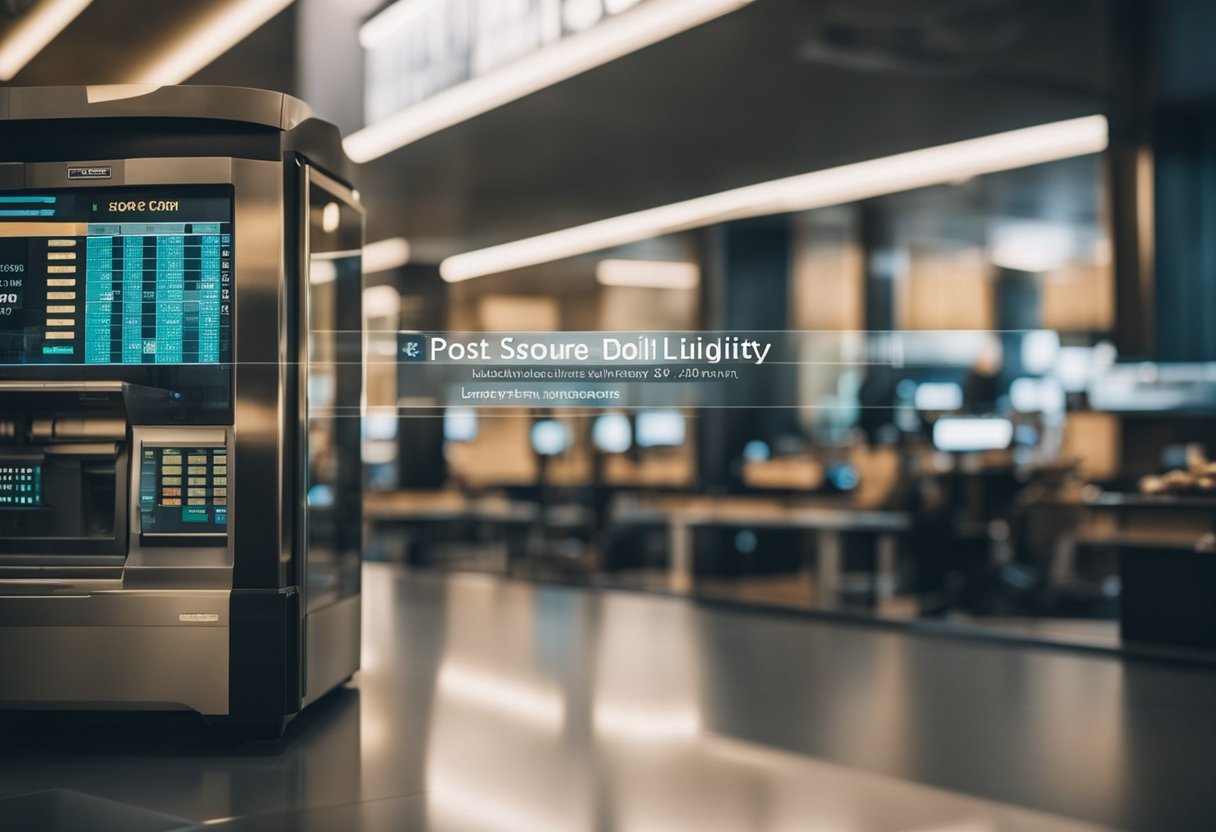Liquidity Management in Post-Trade Operations: Best Practices and Strategies
Optimize liquidity management in post-trade operations with our expert insights. Discover best practices and strategies to improve efficiency.

Liquidity management is an essential aspect of post-trade operations that helps organizations maintain their financial stability and optimize their cash flow.
Liquidity management involves managing an organization's cash and cash equivalents to ensure that it has sufficient funds to meet its obligations and take advantage of investment opportunities.
Effective liquidity management requires a comprehensive understanding of an organization's cash flows, financial obligations, and investment opportunities.

Post-trade operations refer to the processes that occur after a transaction has been executed, including trade confirmation, clearing, and settlement. These processes involve a range of activities, including reconciliation, risk management, and regulatory compliance.
Liquidity management plays a critical role in post-trade operations, as it enables organizations to manage their cash flows effectively and ensure that they have sufficient funds to meet their settlement obligations.
Key Takeaways:
- Effective liquidity management is essential for organizations to maintain financial stability and optimize their cash flow.
- Post-trade operations involve a range of activities, including trade confirmation, clearing, and settlement, and liquidity management plays a critical role in ensuring that organizations have sufficient funds to meet their settlement obligations.
- Technology and automation can help organizations improve their liquidity management processes and mitigate operational risks in post-trade operations.
Understanding Liquidity Management
Liquidity management is crucial to a company's financial management, particularly in post-trade operations. It refers to the process of ensuring that a company has enough cash and other liquid assets to meet its financial obligations as they arise.
For firms, liquidity management is essential for ensuring solvency and financial stability. When a company does not have enough cash to meet its obligations, it may need to sell assets quickly, which could result in losses and damage to its reputation.
In investment, liquidity management is essential for ensuring investors can buy and sell assets quickly and efficiently. If a market is illiquid, finding a buyer or seller for an asset may be difficult, which could result in significant price fluctuations.
Effective liquidity management can also improve a company's profitability. Companies can take advantage of investment opportunities or make strategic acquisitions. Ensuring that cash is available when needed
In post-trade operations, liquidity management is essential for ensuring that trades settle on time. Settlement failures can result in significant costs and reputational damage. By managing liquidity effectively, firms can reduce the risk of settlement failures and improve operational efficiency.
Liquidity management is a critical function for firms, markets, and investors. Companies can maintain financial stability, improve profitability, and reduce risk. Ensuring that cash is available when needed
Role of Technology in Post-Trade Operations
Technology has played an increasingly important role in post-trade operations, enabling firms to streamline processes, reduce costs, and improve efficiency. The adoption of advanced technologies such as AI, automation, APIs, real-time data, and distributed ledger technology has become critical in achieving these goals.
Legacy systems have been a major challenge for post-trade operations, often requiring significant manual intervention and increasing the risk of errors. However, the adoption of modern technology has allowed firms to overcome these challenges and achieve greater accuracy and efficiency. For example, AI can play an essential role in reducing post-trade processing inefficiencies by easing decision-making through automated self-learning. Similarly, automation can help reduce manual intervention, minimize errors, and improve the speed of processing.
APIs have also become increasingly crucial in post-trade operations, enabling firms to integrate with external systems and access real-time data. This has allowed firms to improve their decision-making capabilities and respond more quickly to changing market conditions. Real-time data has also become critical in post-trade operations, allowing firms to monitor and manage real-time risk.
Distributed ledger technology (DLT) is another technology that has the potential to transform post-trade operations. DLT can provide a secure, transparent, and efficient way to manage the settlement process, reducing the need for intermediaries and improving the speed and accuracy of settlement.
In summary, technology has become a critical component in post-trade operations, enabling firms to overcome legacy system challenges and achieve greater accuracy and efficiency. The adoption of advanced technologies such as AI, automation, APIs, real-time data, and distributed ledger technology has become increasingly important in achieving these goals.
Post-Trade Processing and Settlement

Post-trade processing and settlement refer to the activities that occur after a securities transaction is executed. These activities involve matching, clearing, and settling trades and reconciling any discrepancies that may arise during the process. Post-trade processing is a crucial part of the securities trade lifecycle, as it helps to ensure that trades are settled accurately and efficiently, minimizing settlement risk.
Matching is the first step in post-trade processing, where the details of a trade are compared between the buyer and seller to ensure that they are in agreement. Clearing involves the transfer of ownership of the securities from the seller to the buyer, while settlement involves transferring funds from the buyer to the seller. Reconciliation is comparing and verifying the trade details between the buyer and seller to ensure that they match.
Post-trade processing and settlement can be complex and involve multiple parties, including brokers, custodians, and clearinghouses. Each party has a specific role to play in the process and must work together to ensure that trades are settled accurately and efficiently.
Settlement risk is a critical concern in post-trade processing, as it refers to the risk that one party may fail to deliver the securities or funds required to complete the trade. Netting, collateralization, and other risk management techniques can mitigate settlement risk risk.
In conclusion, post-trade processing and settlement are critical components of the securities trade lifecycle. These activities ensure that trades are settled accurately and efficiently, minimizing settlement risk. By working together, brokers, custodians, and clearinghouses can help to ensure that post-trade processing is conducted smoothly and effectively.
Regulations and Compliance in Liquidity Management

Liquidity management is a critical aspect of post-trade operations that requires strict adherence to regulations and compliance requirements. Regulatory bodies such as the Securities and Exchange Commission (SEC) have set out rules that govern liquidity management practices to ensure transparency and control in the financial markets.
Broker-dealers are required to establish and maintain adequate liquidity controls as part of their risk management framework. As per Rule 17a-3(a)(23) of the Exchange Act, firms meeting the thresholds must maintain current records documenting their credit, market, and liquidity risk management controls. Firms must also provide transparency in their liquidity risk management practices, including the use of stress testing and contingency planning.
In addition to SEC regulations, broker-dealers must comply with other regulatory bodies such as FINRA, which established a new Supplemental Liquidity Schedule (SLS) to monitor potential adverse changes in firms' liquidity risk. Compliance with these regulations is essential in maintaining the integrity of the financial markets and protecting investors' interests.
Firms must establish a robust liquidity management framework that aligns with regulatory requirements. This framework should include policies and procedures for monitoring, measuring, and managing liquidity risk. Firms must also ensure that their liquidity management practices are aligned with their overall risk management strategies.
In conclusion, regulatory compliance is crucial to liquidity management in post-trade operations. Firms must establish and maintain adequate liquidity controls that align with regulatory requirements to ensure transparency and control in the financial markets.
Operational Risks and Mitigation

Post-trade operations are rife with operational risks that can have significant consequences if not managed effectively. Operational risks refer to the potential for losses resulting from inadequate or failed internal processes, people, and systems or external events. These risks can stem from a variety of sources, including human error, system failures, and inadequate controls.
One of the most significant operational risks in post-trade operations is settlement risk. Settlement risk arises when one party in a transaction fails to deliver securities or cash as agreed, potentially causing significant financial losses. Settlement risk can be mitigated by establishing robust exception management processes and controls that ensure timely identification and resolution of settlement issues.
Another operational risk in post-trade operations is liquidity risk. Liquidity risk refers to the potential for losses resulting from a firm's inability to meet its financial obligations as they come due. Effective liquidity management is critical to ensuring that a firm can meet its obligations and avoid financial distress. This includes maintaining adequate cash and other liquid assets and establishing contingency funding plans.
Operational risks can also arise from failures in internal controls and processes. For example, manual operations on siloed and disparate post-trade applications can create risks of incorrect and duplicate payments, delays, and costs. Firms can mitigate these risks by implementing automated solutions that provide end-to-end post-trade processing capabilities, including trade matching, netting, and settlement.
Overall, effective risk management is critical to ensuring the smooth operation of post-trade operations. This includes establishing robust controls and processes to mitigate operational risks, as well as maintaining adequate levels of liquidity and contingency funding. By taking a proactive approach to risk management, firms can minimize the potential for losses and ensure the stability of their post-trade operations.
The Role of Automation in Post-Trade Operations

Automation is playing an increasingly important role in post-trade operations, particularly in the area of liquidity management. By automating manual processes, banks and brokers can reduce the risk of errors, increase efficiency, and improve operational efficiencies.
One of the key benefits of automation is the ability to process trades in real time. This means that trades can be settled more quickly, reducing the risk of failed trades and improving liquidity management. Automated systems can also provide real-time monitoring of trades, allowing banks and brokers to identify and resolve issues more quickly.
Another advantage of automation is the ability to reduce the reliance on manual processes. Manual processes are time-consuming and prone to errors, which can lead to delays and increased costs. By automating these processes, banks and brokers can reduce the risk of errors and improve efficiency.
In addition to improving liquidity management, automation can also help banks and brokers comply with regulatory requirements. Automated systems can provide real-time reporting and monitoring, making identifying and addressing compliance issues easier.
Overall, automation is becoming essential for banks and brokers looking to improve their post-trade operations. By automating manual processes and improving operational efficiencies, banks and brokers can reduce the risk of errors, improve liquidity management, and comply with regulatory requirements more efficiently.
The Impact of Market Trends on Liquidity Management

Various market trends influence liquidity management in post-trade operations. One of the significant trends is the fragmentation of markets. As markets become more fragmented, liquidity becomes more dispersed and more challenging to manage. This trend has led to the development of new liquidity management strategies that focus on consolidating cash balances from different markets into a single account.
Another trend that has impacted liquidity management is the need for flexibility. The market is constantly changing, and liquidity managers need to be able to respond to these changes quickly. This requires a flexible approach to liquidity management that can adapt to changing market conditions.
Counterparties are also an essential consideration when it comes to liquidity management. The creditworthiness of counterparties can impact the availability of liquidity, and liquidity managers need to be aware of the creditworthiness of their counterparties. This requires a robust counterparty risk management framework that can assess the creditworthiness of counterparties and manage the associated risks.
Spreads are another factor that can impact liquidity management. As spreads widen, it becomes more expensive to trade, and liquidity managers need to be able to manage these costs effectively. This requires a deep understanding of the market and the ability to execute trades in a cost-effective manner.
Overall, market trends significantly impact liquidity management in post-trade operations. Liquidity managers must be aware of these trends and develop strategies to adapt to changing market conditions. By doing so, they can ensure that they have the liquidity they need to meet their obligations and manage risks effectively.
The Future of Liquidity Management in Post-Trade Operations

Liquidity management is a crucial aspect of post-trade operations, ensuring that firms have access to sufficient funds to meet their obligations. As the financial landscape continues to evolve, the future of liquidity management in post-trade operations is likely to be shaped by several critical trends.
Post-Trade Technology
Post-trade technology is rapidly advancing, with new platforms and solutions that promise to streamline operations and reduce inefficiencies. These technologies have the potential to significantly improve liquidity management, providing real-time data and analytics that can help firms make more informed decisions about their liquidity needs.
Real-Time Data
Real-time data is becoming increasingly crucial in post-trade operations, providing firms with up-to-the-minute information about their liquidity position. This data can identify potential liquidity shortfalls before they occur, allowing firms to manage their liquidity risk proactively.
Distributed Ledger Technology (DLT)
Distributed ledger technology (DLT) has the potential to revolutionize post-trade operations, providing end-to-end transparency and reducing the need for intermediaries. This technology can significantly improve liquidity management by providing real-time visibility into the movement of funds, enabling firms to manage their liquidity positions more effectively.
End-to-End
End-to-end solutions are becoming increasingly popular in post-trade operations, providing firms with a single platform for managing all aspects of their post-trade activities. These solutions can significantly improve liquidity management by providing firms with a holistic view of their liquidity position, enabling them to make more informed decisions about their liquidity needs.
Inefficiencies
Despite these advances, inefficiencies in post-trade operations can still impact liquidity management. These inefficiencies can delay the movement of funds, creating liquidity shortfalls and increasing liquidity risk. Firms must continue to work to identify and address these inefficiencies to ensure that their liquidity management strategies are effective.
In conclusion, the future of liquidity management in post-trade operations is likely to be shaped by a number of key trends, including post-trade technology, real-time data, distributed ledger technology, end-to-end solutions, and inefficiencies. By staying abreast of these trends and leveraging the latest technologies and solutions, firms can improve their liquidity management strategies and reduce their liquidity risk.


